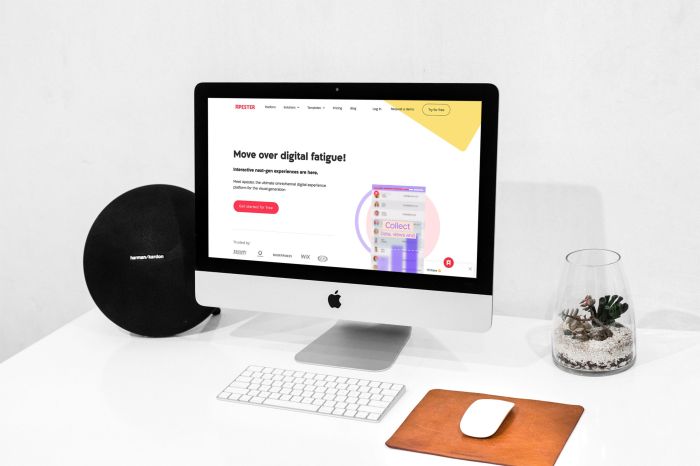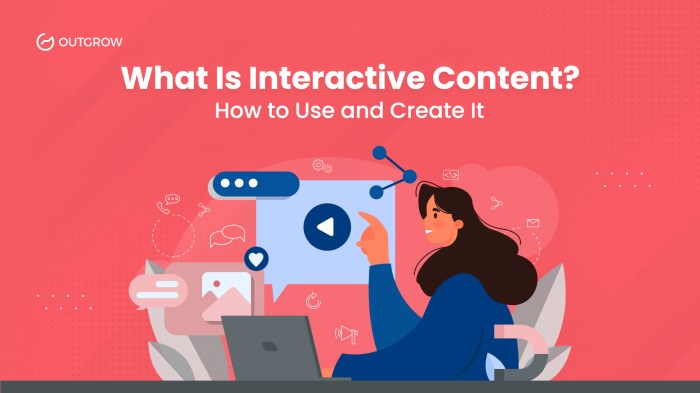Creating Interactive Content takes center stage, inviting readers into a world of engaging digital experiences. From quizzes to games, explore how to captivate your audience with interactive elements.
Introduction to Interactive Content
Interactive content in the digital context refers to any type of content that requires active engagement from the audience. This can include quizzes, polls, interactive videos, games, and more.
Interactive content is essential for engaging audiences because it allows for a two-way conversation between the content creator and the viewer. It creates a more personalized and immersive experience, resulting in higher levels of engagement and retention.
Popular Interactive Content Formats
- Quizzes: Interactive quizzes are a fun and engaging way to test knowledge on a specific topic while keeping the audience entertained.
- Interactive Videos: These videos allow viewers to make choices that affect the storyline, creating a more personalized viewing experience.
- Polls: Polls are a great way to gather feedback from the audience and make them feel involved in the content creation process.
- Games: Interactive games can range from simple puzzles to complex simulations, providing entertainment while keeping the audience engaged.
Types of Interactive Content

Interactive content comes in various forms, each serving a different purpose in engaging users and driving interaction. Let’s explore some of the most common types:
Quizzes
Quizzes are a popular form of interactive content that allows users to test their knowledge on a particular topic. They are effective in driving user engagement as they provide immediate feedback and a sense of accomplishment upon completion. For example, Buzzfeed’s quizzes on personality types have gone viral, attracting millions of users.
Polls
Polls are another interactive content type that allows users to voice their opinions on a specific question or topic. They are great for engaging users and gathering valuable insights. A well-known example is Twitter polls, where users can quickly and easily participate in polls shared by others.
Calculators
Calculators are interactive tools that allow users to input data and receive customized results based on specific calculations. They are highly engaging as they provide personalized information to users. A good example is the mortgage calculator on Zillow’s website, which helps users estimate their monthly payments.
Games
Games are a fun and interactive way to engage users while also providing entertainment and a break from regular content. They can be highly effective in driving user engagement and increasing time spent on a website. An example is the “Doodle Jump” game integrated into Google’s search engine on certain occasions.
Designing Interactive Content
Creating engaging interactive content requires following key design principles that captivate the audience and encourage active participation. Designers must focus on user experience (UX) to ensure that the interactive elements are intuitive, seamless, and enjoyable for the users. Optimizing interactive content for different devices and platforms is essential to reach a wider audience and provide a consistent experience across all platforms.
Key Design Principles
When designing interactive content, consider the following key principles to create engaging experiences:
- Clear Navigation: Ensure that users can easily navigate through the interactive elements without confusion.
- Visual Appeal: Use visually pleasing graphics, animations, and colors to enhance the overall design.
- Interactivity: Include interactive elements such as quizzes, polls, and games to engage users and encourage participation.
- Feedback Mechanism: Provide feedback to users to let them know their actions have an impact and keep them engaged.
Importance of User Experience (UX)
User experience (UX) plays a crucial role in interactive content design as it determines how users interact with the content and how they perceive the overall experience. A positive user experience leads to higher engagement, increased retention, and improved brand loyalty. Designers must prioritize UX by focusing on usability, accessibility, and aesthetics to create interactive content that resonates with the audience.
Tips for Optimizing Interactive Content
To optimize interactive content for different devices and platforms, consider the following tips:
- Responsive Design: Ensure that the interactive content is responsive and adapts to various screen sizes and resolutions.
- Performance Optimization: Optimize the performance of interactive elements to ensure smooth loading and seamless user experience.
- Cross-Browser Compatibility: Test the interactive content on different browsers to ensure compatibility and consistency across all platforms.
- Touchscreen Compatibility: If targeting mobile users, make sure that interactive elements are optimized for touchscreen devices for a better user experience.
Tools and Platforms for Creating Interactive Content

Creating interactive content requires the right tools and platforms to bring your ideas to life. Let’s explore some popular options and compare their features and capabilities.
Popular Tools for Developing Interactive Content
- Adobe Animate: Known for its animation capabilities, Adobe Animate is a versatile tool for creating interactive content with features like timeline-based animations and interactivity.
- H5P: An open-source platform that allows users to create and share interactive content like quizzes, presentations, and games using a variety of content types.
- Unity: Primarily used for game development, Unity is also suitable for creating interactive 3D content and simulations.
Comparison of Features and Capabilities
- Adobe Animate offers robust animation tools, making it ideal for creating visually appealing interactive content.
- H5P’s open-source nature allows for easy collaboration and sharing of interactive content across different platforms.
- Unity provides advanced 3D capabilities, making it a powerful tool for creating immersive interactive experiences.
Pros and Cons of Third-Party Platforms vs. Custom Development
- Third-Party Platforms:
- Pros: Quick and easy to use, no need for coding skills, often come with templates and pre-built assets.
- Cons: Limited customization options, may have subscription fees or limitations on functionality.
- Custom Development:
- Pros: Complete control over design and functionality, tailored to specific needs and goals.
- Cons: Requires coding expertise, time-consuming and costly to develop from scratch.
Measuring the Success of Interactive Content
When it comes to interactive content, measuring its success is crucial to understand how well it is performing and engaging your audience. By identifying key metrics and analyzing user data, you can make informed decisions to improve your interactive content.
Key Metrics for Measuring Performance
- Click-through Rate (CTR): This metric measures the number of times users interact with your content by clicking on links or buttons.
- Time Spent: Analyzing how much time users spend engaging with your interactive content can indicate their level of interest.
- Conversion Rate: Tracking how many users take the desired action after interacting with your content, such as signing up for a newsletter or making a purchase.
- Shares and Social Engagement: Monitoring how often users share your interactive content on social media platforms can help gauge its reach and impact.
Analyzing User Engagement and Interaction Data, Creating Interactive Content
- Use Google Analytics or other tracking tools to gather data on user behavior, such as page views, bounce rates, and session duration.
- Segment your audience to understand how different demographics or user groups interact with your content.
- Analyze heatmaps and scroll maps to visualize where users are clicking and how far they are scrolling on your interactive content.
Strategies for Improving Interactive Content
- Optimize for mobile devices to ensure a seamless user experience across different screen sizes.
- A/B test different interactive elements to see which ones resonate best with your audience and drive higher engagement.
- Collect feedback from users through surveys or polls to understand what they like or dislike about your interactive content.
Interactive Content Trends: Creating Interactive Content
Interactive content creation is constantly evolving, with new trends shaping the way users engage with digital content. Technologies like Augmented Reality (AR) and Virtual Reality (VR) are revolutionizing the interactive content landscape, providing immersive experiences that captivate audiences like never before.
Impact of AR/VR on Interactive Content Experiences
AR and VR technologies have opened up a whole new world of possibilities for interactive content. With AR, users can overlay digital elements onto the real world, creating unique and engaging experiences. VR, on the other hand, transports users to virtual environments, allowing for full immersion in the content.
These technologies have a profound impact on how interactive content is created and consumed. Brands are leveraging AR and VR to create interactive experiences that are not only entertaining but also highly memorable. From interactive product demonstrations to virtual tours, the possibilities are endless with AR and VR.
Future of Interactive Content in Digital Marketing
As technology continues to advance, the future of interactive content in digital marketing looks promising. Interactive content is becoming increasingly personalized, engaging users on a one-on-one level. This trend is likely to continue, with brands focusing on creating content that resonates with their target audience.
Moreover, interactive content is expected to play a crucial role in driving customer engagement and brand loyalty. By providing interactive experiences that are both informative and entertaining, brands can forge deeper connections with their customers. The future of interactive content in digital marketing is bright, with endless opportunities for brands to stand out in a crowded digital landscape.